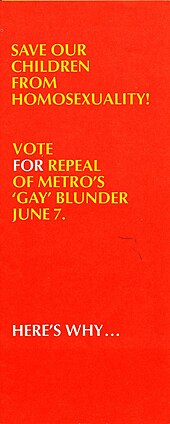https://en.wikipedia.org/wiki/Discrimination_against_people_with_HIV/AIDS
Discrimination against people with HIV/AIDS or serophobia is the prejudice, fear, rejection and discrimination against people afflicted with HIV/AIDS (PLHIV; people living with HIV/AIDS). Discrimination is one manifestation of stigma, and stigmatizing attitudes and behaviors may fall under the rubric of discrimination depending on the legislation of a particular country. HIV stands for human immunodeficiency virus. If left untreated, HIV can lead to the disease AIDS (acquired immunodeficiency syndrome). HIV/AIDS is a sexually transmitted disease and cannot be cured, but with proper treatment, the individual can live just as long as without the disease.
HIV/AIDS discrimination exists around the world, including ostracism, rejection, discrimination, and avoidance. Consequences of stigma and discrimination against PLHIV may result in low turn-out for HIV counselling and testing, identity crises, isolation, loneliness, low self-esteem and lack of interest in containing the disease.
Much HIV/AIDS stigma or discrimination involves homosexuality, bisexuality, promiscuity, sex workers, and intravenous drug use.
In many developed countries, a strong correlation exists between HIV/AIDS and male homosexuality or bisexuality (the CDC states, "Gay, bisexual, and other men who have sex with men (MSM) represent approximately 2% of the United States population, yet are the population most severely affected by HIV"), and association is correlated with higher levels of sexual prejudice such as homophobic attitudes. An early name for AIDS was gay-related immune deficiency or GRID. During the early 1980s, HIV/AIDS was "a disorder that appears to affect primarily male homosexuals".
Some forms of serious discrimination can include: being excluded from consideration for a job, being prohibited from buying a house, needing to pay extra money when renting housing, compulsory HIV testing without prior consent or protection of confidentiality; the quarantine of HIV infected individuals and, in some cases, the loss of property rights when a spouse dies. HIV testing without permission or security may also be considered as wrongdoings against those with HIV. The United States' disability laws prohibit HIV/AIDS discrimination in housing, employment, education, and access to health and social services. The U.S. Department of Housing and Urban Development Office of Fair Housing and Equal Opportunity enforces laws prohibiting housing discrimination based on actual or perceived HIV/AIDS status.
Discrimination against people with HIV/AIDS or serophobia is the prejudice, fear, rejection and discrimination against people afflicted with HIV/AIDS (PLHIV; people living with HIV/AIDS). Discrimination is one manifestation of stigma, and stigmatizing attitudes and behaviors may fall under the rubric of discrimination depending on the legislation of a particular country. HIV stands for human immunodeficiency virus. If left untreated, HIV can lead to the disease AIDS (acquired immunodeficiency syndrome). HIV/AIDS is a sexually transmitted disease and cannot be cured, but with proper treatment, the individual can live just as long as without the disease.
HIV/AIDS discrimination exists around the world, including ostracism, rejection, discrimination, and avoidance. Consequences of stigma and discrimination against PLHIV may result in low turn-out for HIV counselling and testing, identity crises, isolation, loneliness, low self-esteem and lack of interest in containing the disease.
Much HIV/AIDS stigma or discrimination involves homosexuality, bisexuality, promiscuity, sex workers, and intravenous drug use.
In many developed countries, a strong correlation exists between HIV/AIDS and male homosexuality or bisexuality (the CDC states, "Gay, bisexual, and other men who have sex with men (MSM) represent approximately 2% of the United States population, yet are the population most severely affected by HIV"), and association is correlated with higher levels of sexual prejudice such as homophobic attitudes. An early name for AIDS was gay-related immune deficiency or GRID. During the early 1980s, HIV/AIDS was "a disorder that appears to affect primarily male homosexuals".
Some forms of serious discrimination can include: being excluded from consideration for a job, being prohibited from buying a house, needing to pay extra money when renting housing, compulsory HIV testing without prior consent or protection of confidentiality; the quarantine of HIV infected individuals and, in some cases, the loss of property rights when a spouse dies. HIV testing without permission or security may also be considered as wrongdoings against those with HIV. The United States' disability laws prohibit HIV/AIDS discrimination in housing, employment, education, and access to health and social services. The U.S. Department of Housing and Urban Development Office of Fair Housing and Equal Opportunity enforces laws prohibiting housing discrimination based on actual or perceived HIV/AIDS status.
Structural violence
Structural violence is an important factor in the treatment of people
afflicted with AIDS. Paul Farmer argues that social determinants
affecting the lives of certain cultural groups alter their risk of
infections and their ability to access treatment.
For example, access to prophylaxis, access to antiretroviral therapy,
and susceptibility to illness and malnutrition are all factors which
change people's overall risk of illness due to HIV/AIDS. This causes
large difference in the rate of illness due to HIV/AIDS in various
social/cultural groups.
Farmer also argues that social intervention may be key in altering the
gap in treatment between these groups of people. Educating doctors on
the interactions between social life and healthcare would help level out
the injustices in healthcare.
Research
Current
research has found that discrimination against people afflicted with
HIV is a contributing factor for delayed initiation of HIV treatment. As many as 20–40% of Americans who are HIV positive do not begin a care regimen within the first six months after diagnosis.
When individuals begin treatment late in the progression of HIV (when
CD4+ T cell counts are below 500 cells/µL), they have 1.94 times the
risk of mortality compared to those whose treatment is initiated when
CD4+ T cells are still about 500 cells/µL.
In a 2011 study published in AIDS Patient Care and STDs (sample size 215), most of the barriers to care described involve stigma and shame.
The most common reasons of not seeking treatment are "I didn't want to
tell anyone I was HIV-positive", "I didn't want to think about being
HIV-positive", and "I was too embarrassed/ashamed to go".
The presence and perpetuation of HIV stigma prevents many who are able
to obtain treatment from feeling comfortable about addressing their
health statue.
Additional research has found that education decreases HIV/AIDS
discrimination and stigma in communities. A 2015 research study by the
University of Malaya found that in Nigerian populations, "Educating the
population with factual information on HIV/AIDS is needed to reduce
stigma and discrimination towards PLHIV in the community."
Surveys from 56,307 men and women from various educational and
socio-economic levels and ages ranging from 15 to 49 years old, found
that wealthier individuals with secondary and post-secondary were
nonpartisan towards PLHIV. On the contrary, young adults, the poor, and
men were more likely to be biased towards PLHIV. Many people also
believe that AIDS is related to homosexuality.
Even so, research has found that societal structure and beliefs
influence the prevalence stigma and discrimination. "The two concepts of
right-wing authoritarianism and social dominance orientation have
proven to be strong and reliable predictors of different types of
prejudice."
Similar to sexism, racism, and other forms of discrimination, the
raised and taught belief to view PLHIV as deviants and outcasts as
children who become adults with warped view of PLHIV. "In order to cope
with threat, people may adhere to a submissive authoritarian ideology,
which will lead them to reject other groups that are perceived as
deviant and may threaten their worldview and their system of values."
There are challenges for medical volunteers and nurses involved
in caring for people with HIV/AIDS. In third-world countries and some
communities in the Americas, low resource funding can make it
detrimental to the success of providing proper care to PLHIV that cannot
otherwise afford healthcare or don't possess medical insurance or other
forms of payments. The nurses or medical volunteers may lack the proper
knowledge of how to treat the individuals too, if they lack resources
and funding. In Province, South Africa, 223 nurses were surveyed on
their qualification and knowledge of AIDS. The nurses scored on Maslach
Burnout Inventory; AIDS Impact Scale and Beck's Depression
Inventory. The total knowledge score obtained by all the participants
ranged from 2 to 16, with an average of 12.93 (SD = 1.92) on HIV/AIDS knowledge.
The rise of PLWH impacts on the already burdened health-care workforce
and predisposes nurses to workplace stress as they carry out their
duties of caring for PLWH.
The discriminatory behaviors of healthcare workers who are expected to
be more knowledgeable about epidemiology and control of HIV including
its social aspects are not helping matters. They often take extreme
precaution against HIV positive clients for fear of transmission, and at
times may refuse HIV positive clients some aspects of care. This is
supported by another study in which health staff was said to be worried
about occupational exposure, with high levels of anxiety and fear when
dealing with HIV-positive persons.
In some countries, to prevent the knowledge of PLHIV, medical reports do not reveal HIV/AIDS study. In Africa, a person's cause of death may be concealed in order for policies to pay out.
This distortion of information does not help in the fight against the
spread of HIV and AIDS. Medical volunteers, nurses, and doctors,
especially in low-income areas, will disclose their status without fear
of rejection, isolation and discriminated against.
The psychological support for PLHIV in certain countries around
the world scarce. In some places like China and Africa, PLHIV have been
noted to have high level of stress due to discrimination and family
members contributes to stress level among PLHIV. Research is still being
done to see if therapy and other psychological services will be a
buffer between the discrimination and stress. The study highlights the
importance to reduce discrimination toward PLHIV and the difficulty to
alleviate its negative consequences. In China, It is warranted to
improve mental health among PLHIV in China and it is still important to
provide in PLHIV as it has direct effects on perceived stress.
PLHIV choose to not tell their HIV status to others, they tend to seek
help from the health care professionals and programs and have
considerable trust towards outside support. Health service providers are
hence promising sources of social support for PLHIV.
Violence
Discrimination
that is violent or threatening violence stops a lot of individuals for
getting tested for HIV, which does not aid in curing the virus.
Violence is an important factor against the treatment of people
afflicted with AIDS. A study done on PLHIV in South Africa shows that
out of a study population of 500, 16.1% of participants reported being
physically assaulted, with 57.7% of those resulting from one's intimate
partners; such as husbands and wives. The available data show high rates
of participants socially isolating themselves from both friends and
family, in addition to avoiding the seeking of treatment at hospitals or
clinics, due to increasing internalized fears.
Any violence against HIV infected individuals or people who are
perceived to be infected with HIV can severely shut down the advancement
of treatment in response to the progression of the disease.
Paul Farmer
argues that social determinants affecting the lives of certain cultural
groups alter their risk of infections and their ability to access
treatment.
For example, access to prophylaxis, access to antiretroviral therapy,
and susceptibility to illness and malnutrition are all factors which
change people's overall risk of illness due to HIV/AIDS. This causes
large difference in the rate of illness due to HIV/AIDS in various
social/cultural groups. Farmer also argues that social intervention may
be key in altering the gap in treatment between these groups of people.
Educating doctors on the interactions between social life and healthcare
would help level out the injustices in healthcare.
Influence on society
Stigma
HIV/AIDS stigma has been further divided into the following three categories:
- Instrumental AIDS stigma—a reflection of the fear and apprehension that are likely to be associated with any deadly and transmissible illness.
- Symbolic AIDS stigma—the use of HIV/AIDS to express attitudes toward the social groups or lifestyles perceived to be associated with the disease.
- Courtesy AIDS stigma—stigmatization of people connected to the issue of HIV/AIDS or HIV- positive people.
HIV-related stigma is very common worldwide.
People who are infected with HIV may be either deliberately or
inadvertently engaged in selective avoidance, ostracism or denigration
of their behaviour.
Research done in South Africa, about the stigma and discrimination in
communities, has found that PLHIV not only experience high levels of
stigma that negatively impact all spheres of their lives, also
interferes psychologically. Internalized stigma and discrimination ran
rampant in the study, but also throughout the PLHIV community. Many
PLHIV in South Africa blamed themselves for their current situation. Globally, nearly half of all people infected with HIV are women.
Stigma, according to Merriam-Webster dictionary, is "a set of
negative and often unfair beliefs that a society or group of people have
about something".
Stigma is often enforced by discrimination, callous actions, and
bigotry. In response, PLHIV have developed self-depreciating mindsets
and coping skills to deal with the social repercussions versus accepting
of their current status and seeking help.
People who are HIV positive often deal with stigma, even though
with the proper medication this can be manageable lifelong disease.And
the existence of AIDS stigma will make AIDS patients under psychological
pressure, which is detrimental to their AIDS treatment. According to
the survey, women with AIDS undertook higher levels of depression,
anxiety and stress than women without AIDS.
It is now possible for a person who HIV+ to have intimate relationship
with someone who is HIV- and not pass the disease to them. It is also
possible for a mother who is HIV+ to not pass it to her child.
In developing countries, people who are HIV+ are discriminated against
at work, school, their community, and even in healthcare facilities.
Discrimination may also increase the spread of HIV because fewer people
will want to get tested. In addition, because of the stigma of AIDS,
people living with AIDS tend to keep their HIV status confidential. They are reluctant to disclose their HIV status to others, including their family, friends and general practitioners. Because AIDS patients choose not to disclose AIDS, which is also likely to increase the spread of AIDS.
Societal relationships
Accordingly,
in countries such as Nigeria, PLHIV are less likely to disclose their
HIV status, due to the repercussion of exclusion of their community. "In
most situations, in order to prevent social rejection, PLHIV will not
disclose their HIV status to avoid being isolated from participating in
the socio-cultural events." This leads to very high-risk behaviors of
passing the illness along to others or delaying the proper treatment.
PLHIV, when shut off from their community. can feel isolated, lonely,
afraid, a lack of motivation, and identity problems. Stigma enhances the
spread and denies the medical research of HIV/AIDS because the social
and medical support are gone. Those individuals can no longer feel like
part of society, which, as humans, we need communities to feel
understood and wanted.
Family and other intimate relationships play a role in the death
rate of PLHIV. Due to the fear of isolation, ignorance, denial, and
discrimination, people will allow HIV to develop into AIDS, further
decreasing life expectancy, since the body's immune system
function will have been significantly lowered. Research done in at
Mvelaphanda Primary School children, in Tembisa, Ekurhuleni Metropolitan
Municipality in Gauteng, South Africa. Many of the children were
orphans due to the death of parents, had sibling deaths, and even some
themselves, who were born with HIV. It was found through survey that if
there is no behavioral change towards HIV/AIDS than no change to fight
the epidemic will occur. At Mvelaphanda Primary school, their mortality
rate is increasing in their children, especially young women. These
women are more at risk than their male counterparts due to many being
involved with older men who have various partners and do not participate
in safe sex practices. Some of these students are themselves parents of
students at the school. The problem is that even when family members
are informed of the cause of death, which is likely to be AIDS, they
choose to inform people that the cause of death was "witchcraft".
Children and other family members tend to deny the truth and are raised
with the belief that HIV and/or AIDS does not exist and they fear to be
bewitched than being infected by the virus.
Along with family bonds and intimate relationships, a spiritual
relationship is strained for PLHIV. In a research study done in the
western region of Saudi Arabia. The stigma is profound in Saudi Arabia
as Islam prohibits behaviours associated with risk factors related to
transmission of HIV, such as non-marital sex, homosexuality and
intravenous drug use. Fear and vulnerability included fear of punishment
from God, fear of being discovered as HIV/ AIDS-positive and fear of
the future and death. PLHIV experienced isolation and lack of
psycho-social and emotional support. In response to their experiences
many participants accepted their diagnoses as destiny and became more
religious, using spirituality as their main coping strategy.



